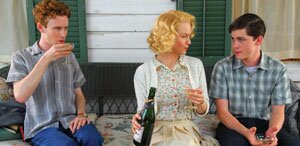MOVIE REVIEW- Identity crisis: <i>One and Only</i> can't decide

PUBLICITY PHOTO
My One and Only is the story of two teenage boys who know what they want to be when they grow up and their mother, who doesn't. The movie doesn't know what it wants to be either– a drama or a comedy. As a result, much of the comic relief comes from making fun of things the dramatic portion is taking seriously.
It's not unusual for a coming-of-age tale to focus more on the mother than the child, as this one does. Many a diva has gotten some of her greatest roles that way, after passing a certain age.
Renée Zellweger might charitably be described as a diva-in-training. When she's as bad as she is here, it's easy to forget how good she was in Chicago, Nurse Betty and, arguably, Cold Mountain, plus a few others. Watching her play a 1950s housewife makes you appreciate how good Julianne Moore was in Far from Heaven.
In 1953, Ann Devereaux (Zellweger) gets out of the house quickly after finding her bandleader husband Dan (Kevin Bacon) there with another woman. She pulls their sons out of school, sends 15-year-old George (Logan Lerman) to buy a car, and hits the road, which leads from New York to Boston, Pittsburgh, St. Louis and eventually Los Angeles.
George's older half-brother, Robbie (Mark Rendall), is gay. This is hammered home in the first 15 minutes by having him cast as Lady Macbeth in the school play, referring to his sensitivity, and having him do needlepoint and try on mom's jewelry.
Ann is determined to take care of herself and her sons, but the only way she knows to do that is to have a man take care of her. The first stops on their trip are places where she has old beaus who might be available again. This allows for brief appearances by Chris Noth, Eric McCormack and Steven Weber before Ann almost finds wedded bliss with David Koechner.
If you know My One and Only is based on incidents in the early life of George Hamilton, it makes one line funny. Having arrived in Los Angeles Ann encourages the boys to go to the beach. "Get some color, George," she tells the son who will one day be more famous for his tan than his talent.
Dan describes his wife as having "delusions of grandeur," which may explain why Zellweger sometimes acts like she's playing Blanche DuBois in A Streetcar Named Desire. She tries to maintain their standard of living but is beaten down by circumstance as their living situations become humbler and humbler. She's even reduced to getting a job!
So much happens, it's a shock to learn at one point that only four months have passed. By this time, George has become settled in St. Louis, has made friends (although we don't see them), and has been encouraged by a teacher to pursue his talent for writing (the first hint we've had that he wants to be a writer).
Hamilton was actually 13 in 1953, but perhaps that was the only year they could get a Cadillac convertible from. (The actual trip was made in a Lincoln.) It doesn't matter. The movie is overflowing with anachronisms, especially in an opening montage that spans the decade of the ‘50s, including a reference to Connie Francis (perhaps intended as homage to Hamilton's future Where the Boys Are co-star) singing "God Bless America," which she wouldn't record until 1959.
Filter-tip cigarettes, TV dinners and the cult status of The Catcher in the Rye, if not technically premature, were not commonplace in 1953. Hugh O'Brian's Wyatt Earp didn't air until 1955 and no one said "Put the pedal to the metal" until the 1970s.
The two funniest lines in the movie, like the one about George getting a tan, come from knowing now what they didn't know then. A military type rants about how, "If the Commies take over, every town will have the same stores"; and a salesman boasts of representing "the product of the future: asbestos." (Actually chain stores and asbestos were pretty common by then, so these lines are also anachronistic– but at least they're funny.)
Nitpicking aside, the period look is the best thing the film has going for it; but it's frequently underlit. This may be to hide some flaws in the sets and costumes but results in the star being hard to see.
Lerman, who showed promise in the Jack & Bobby TV series a few years ago, is disappointing here. He delivers his lines well but gives no hint of any truth behind them. Ironically, this makes him perfect to represent the future George Hamilton!
When a bad performance is one of the only things to praise about a movie, it's not worth your time.
#
1 comment
That always sucks when a movie doesn't even try to be historically accurate. It's lazy screenwriting!
Note to Hollywood: Try harder!
:D